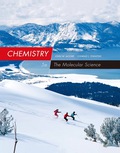
Concept explainers
(a)
Interpretation:
The concentration of
(a)
Answer to Problem 137QRT
The concentration of
Explanation of Solution
Given information is given as,
As known,
So,
Conversion of ppm to ppb as follows,
Hence, the concentration of
(b)
Interpretation:
The molarity of
(b)
Answer to Problem 137QRT
The molarity of
Explanation of Solution
A sample of exactly
Hence, molarity of
(c)
Interpretation:
From one metric ton of cassiterite, number of
(c)
Answer to Problem 137QRT
The number of bottles calculated as
Explanation of Solution
The given reaction;
In exactly one metric ton,
So, the actual mass of Tin is,
The theoretical mass of
The actual mass of
Number of bottles is calculated by using bottle volume; which is calculated by molarity obtained
Hence, number of bottles calculated as is
Want to see more full solutions like this?
Chapter 13 Solutions
EBK CHEMISTRY: THE MOLECULAR SCIENCE
- The density of a 3.75 M aqueous sulfuric acid solution in a car battery is 1.225 g/mL. Express the concentration of the solution in molality, mole fraction H2SO2, and mass percentage of H2SO4.arrow_forwardA solution is made by dissolving 0.455 g of PbBr2 in 100 g of H2O at 50C. Based on the data in Table 8-1, should this solution be characterized as a. saturated or unsaturated b. dilute or concentratedarrow_forwardThe freezing point of 0.10 M KHSO3 is -0.38C. Which of the following equations best represents what happens when KHSO3 dissolves in water? (a) KHSO3(s)KHSO3(aq) (b) KHSO3(s) K+(aq)+HSO3(aq) (c) KHSO3(s) K+(aq)+SO32(aq)+ H+(aq)arrow_forward
- What is the normality of the solution prepared by dissolving 25.2 grams oxalic acid in sufficient water to give 1.2L of.arrow_forwardCalculate the Volume of Carbon Dioxide gas that was produced in the reaction of baking soda and vinegar if we were at STP. 1 teaspoon of baking soda and 1/3 of a cup of vinegar were used in this solutionarrow_forwardWhat will be the normality of a solution obtained by mixing 0.45 N and 0.60 N NaOH in the ratio 2: 1 by volume?arrow_forward
- If 1,5g of potassium dichromate (K2Cr2O7) is used to prepare a standard solution in a 250mL volumetric flask then what will the concentration of the solution be?arrow_forwardThe molar mass of the hormone is 775.7473684g/mol. What is the osmotic pressure in kpa of a 0.145M solution of a Al(NO3)3 At 25 degrees Celsiusarrow_forwardWhat process or processes accounts for the presence of arsenic in well water?arrow_forward
- What is the normality of a 0.010M aqueous solution of the salt Ce(SO4)2?arrow_forwardWhat is the osmotic pressure (in atm) for 390mM K3PO4 at 290.2 K.arrow_forwardThe salt content was extracted from a 12.0000 g junk food sample. The extract was diluted to 100.00 mL. From this solution, 15.00 mL was taken and required 23.75 mL of a 0.08943 M AgNO3 solution to reach the endpoint. What is the percentage by mass of salt as NaCl (58.45 g/mol) in the junk food sample?arrow_forward
 Chemistry & Chemical ReactivityChemistryISBN:9781337399074Author:John C. Kotz, Paul M. Treichel, John Townsend, David TreichelPublisher:Cengage Learning
Chemistry & Chemical ReactivityChemistryISBN:9781337399074Author:John C. Kotz, Paul M. Treichel, John Townsend, David TreichelPublisher:Cengage Learning Chemistry: Principles and PracticeChemistryISBN:9780534420123Author:Daniel L. Reger, Scott R. Goode, David W. Ball, Edward MercerPublisher:Cengage Learning
Chemistry: Principles and PracticeChemistryISBN:9780534420123Author:Daniel L. Reger, Scott R. Goode, David W. Ball, Edward MercerPublisher:Cengage Learning General, Organic, and Biological ChemistryChemistryISBN:9781285853918Author:H. Stephen StokerPublisher:Cengage Learning
General, Organic, and Biological ChemistryChemistryISBN:9781285853918Author:H. Stephen StokerPublisher:Cengage Learning Chemistry: Principles and ReactionsChemistryISBN:9781305079373Author:William L. Masterton, Cecile N. HurleyPublisher:Cengage Learning
Chemistry: Principles and ReactionsChemistryISBN:9781305079373Author:William L. Masterton, Cecile N. HurleyPublisher:Cengage Learning



